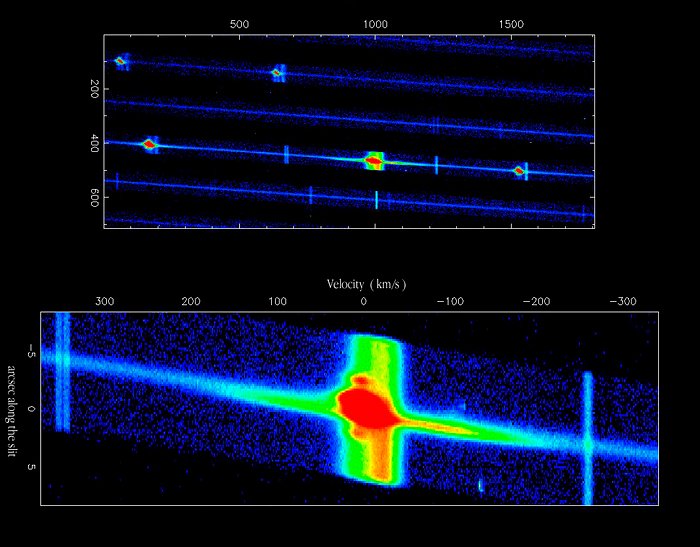H-alpha emission in SN1987A
his false-colour image has been extracted from another UVES echelle spectrum of SN 1987A with a slit width of 1 arcsec. The upper part shows the emission lines of nitrogen, sulfur and hydrogen, as recorded in some of the spectral orders. The pixel coordinates (X,Y) in the original frame are indicated; the red colour indicates the highest intensities. Below is a more detailed view of the complex H-alpha emission line, with the corresponding velocities and the position along the spectrograph slit indicated. Several components of this line can be distinguished. The bulk of the emission (here shown in red colour) comes from the ring surrounding the supernova; the elongated shape here is due to the differential velocity exhibited by the near (to us) and far sides of the ring. The two bright spots on either side are emission from two outer rings. The extended emission in the velocity direction originates from material inside the ring upon which the fastest moving ejecta from the supernova have impacted. The ejecta moving at 30,000 km/s (1/10th the speed of light) have now, 12 years after the explosion, reached the ring of material and the predicted "fireworks" are about to be ignited.) Finally, there is a broad emission extending all along the spectrograph slit (here mostly yellow) upon which the ring emission is superimposed. This is not associated with the supernova itself, but is H-alpha emission by diffuse gas in the Large Magellanic Cloud (LMC) in which SN 1987A is located.
Kilde:ESO
Om billedet
| Id: | eso9944c |
| Type: | Simulation |
| Udgivelsesdato: | 5. oktober 1999 |
| Relaterede pressemeddelelser: | eso9944 |
| Størrelse: | 1074 x 839 px |
Om objektet
| Navn: | SN 1987A |
| Type: | Local Universe : Star : Evolutionary Stage : Supernova |
| Afstand: | 170000 lysår |
| Kategori: | Stars |
Baggrundsbilleder
Farver & filtre
| Bånd | Teleskop |
|---|---|
| Very Large Telescope UVES |
